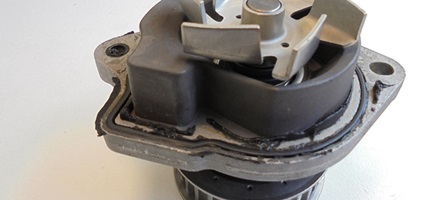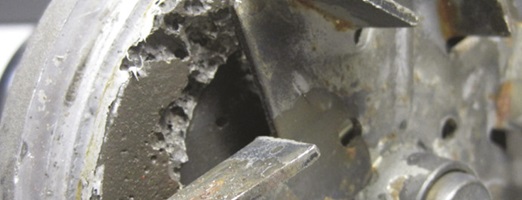Replacing a water pump requires a fair amount of technical expertise. Are you planning on installing a new water pump? These do’s and don’ts will help you avoid 9 common mistakes.
1. Don’t worry if the new water pump looks a little different from the old one
It is possible that there’s a
visual difference between the new water pump you’re about to install and the old pump you have just removed. Perhaps the new one has a metal paddle wheel while the old one had a plastic paddle wheel, or perhaps its shape is somewhat different. Don’t worry about these minor differences; all that matters is the position of the
water pump pulley. It should be at the same height as in the old pump because – if the belt starts rubbing against the pulley – it will become frayed. To check if you’re good to go, simply put both water pumps on your workbench, face down (i.e. with the side that touches the engine), and compare the position of the pulley.
2. Do flush the cooling system
Not
flushing the cooling system is a common mistake that could cost you dearly. After all, the old coolant is likely to be contaminated, and its impurities could settle where the dynamic seal is supposed to form. As a result, these impurities will cause scratches on the dynamic seal surface, which could, in turn, lead to premature pump failure. To remove all the debris from the cooling system, flushing is key. A hose and a standard cleansing agent might do, but using a flush tool like the
Gates Power Clean Flush tool will help you to do the job properly. Tip: if you flush the cooling system with a water pump attached, use the old water pump and not the new one, to prevent impurities from contaminating the new pump.
3. Don’t apply sealant to an O-ring or a dry seal
When changing a water pump, replace all old gaskets and seals with new ones. If your new pump comes with a seal, make sure it’s in impeccable condition before installing it. (Some seals are so thin you could easily damage them when you rip off the packaging.) Perhaps you’re tempted to apply sealant to an O-ring or a dry seal, just to be ‘extra safe’, but these seals don’t need sealant! If your rubber ring won’t stay put, just use a drop of coolant instead.
Only apply sealant if the vehicle manufacturer recommends it, and don’t use too much of it. Put a thin, even bead along the edge and wipe off the excess before mounting the water pump. If you do this after you’ve mounted the water pump, you won’t be able to see the excess sealant on the inside, where it will damage the cooling system. The sealant will clump together into chunks that contaminate the coolant and can cause leakage or do terrible damage to the thermostat.

Only apply sealant if the vehicle manufacturer recommends it, and when sealant is prescribed, be sure to use in the correct way.
4. Don’t use coolant that’s old or too cold
Collecting the coolant from your old water pump and reusing it may seem like a sensible (and economical) thing to do, but we strongly advise against it. After all, coolant tends to deteriorate: it has an expiry date. Refill the cooling system with
new coolant and make sure …
- … to use the kind recommended by the vehicle manufacturer (don’t start mixing coolants either, because they might counteract each other).
- … to get the proportions right. If you add too little antifreeze, your cooling system is more likely to freeze, but adding too much might also be harmful. We recommend a fifty-fifty mix of water and antifreeze (make that 65% antifreeze and 35% water for Alpine-cold or Siberian climates).
- … to mix in warm water with your antifreeze – as odd as that may sound. Adding cold coolant to a heated engine can cause thermal shock and damage the seal, even in a new water pump.
- … to use distilled, deionized or even bottled water, but never tap water. Regular tap water can be very hard, leaving mineral deposits inside the radiator, heater core and engine block. When these deposits break off, they can damage the water pump seal.
5. Do rotate the pump manually
A lot of mechanics stick to the following procedure: replace the water pump, tighten the bolts, install the belt, tighten the tensioner, refill the cooling system … and start the engine (or just rev it up). But coolant takes a little time to get everywhere it’s supposed to be, so the water pump
runs dry for a few seconds. This ruins the seal and heightens the risk of premature leaks or a noisy water pump. Instead we’d advise you to ease the car down after you’ve installed a new water pump, refill the cooling system, lift the car back up and
manually rotate the pump about ten times, all the while making sure it rotates freely. Due to this rotating movement, coolant gets sucked into the mechanical seal component, effectively creating a film, which keeps coolant from spilling out.
6. Don’t worry about seepage from the weep hole
Every mechanically driven water pump has a weep hole that might leak a little in the beginning. Some
seepage from the weep hole is completely normal with a new water pump: a mechanical seal has a break-in period of about ten minutes (meaning that it takes about ten minutes of operation for the seal to properly seal itself). However, if you still see seepage a few days after you’ve replaced the pump, or if you notice more pronounced seepage or even drips from the weep hole, you do have a problem: these symptoms point to a faulty installation.
7. Do properly vent the cooling system
When you’re done replacing a water pump, it’s good practice to
burp the cooling system to get rid of all the trapped air. Some thermostats have a small hole at 12 o’clock, and a jiggle pin which allows the air to escape (while preventing new air from getting in).
8. Do change the water pump, belt and other drive components at the same time
It is crucial to inspect the
belt drive system that is driving the water pump, while you’re at it. A bad belt and tensioner cause premature bearing and shaft failure and drastically reduce pump life. Conversely, a leaking water pump inevitably affects the belt and tensioner. That’s why we recommend changing the water pump, belt and other drive components all at the same time. Our
timing belt kits and
accessory belt kits include water pumps or even
water pumps and thermostats.
9. Do change the coolant every five years
Coolant contains anti-rust agents, corrosion inhibitors and lubricants for the water pump, yet these components deteriorate over time. Our rule of thumb:
change the coolant every five years to preclude cavitation problems. After all, coolant tends to become more acidic over time, increasing the risk of cavitation – a bizarre phenomenon in which what seem like tiny ‘air bubbles’ pop and damage the paddle wheel and other components. (These ‘air bubbles’ actually contain super-hot vapour that can crack plastic and erode metal if it implodes). You cannot see the
cavitation bubbles, but engine overheating and weep hole leaks are tell-tale signs.

Cavitation: vapour cavities (‘air bubbles’) in the coolant collapse with explosive force, pockmarking the pump’s individual components.